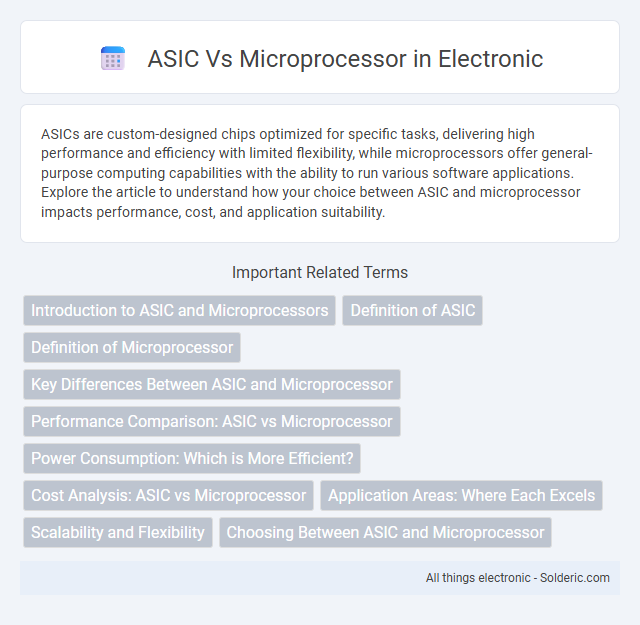ASICs are custom-designed chips optimized for specific tasks, delivering high performance and efficiency with limited flexibility, while microprocessors offer general-purpose computing capabilities with the ability to run various software applications. Explore the article to understand how your choice between ASIC and microprocessor impacts performance, cost, and application suitability.
Comparison Table
| Feature | ASIC (Application-Specific Integrated Circuit) | Microprocessor |
|---|---|---|
| Definition | Custom-designed chip for a specific application or task | General-purpose processor executing a wide range of instructions |
| Purpose | Optimized for one dedicated function | Flexible, supports multiple applications |
| Performance | High speed, efficient with low latency | Moderate speed, dependent on clock and architecture |
| Power Consumption | Low power due to task-specific design | Higher power as it supports various tasks |
| Development Cost | High initial design and fabrication expense | Lower, off-the-shelf availability |
| Flexibility | Inflexible, fixed functionality | Highly flexible, programmable |
| Use Cases | Cryptocurrency mining, telecom equipment, custom hardware acceleration | Computers, smartphones, embedded systems |
| Production Volume | Best for high-volume production | Suitable for low to medium volume |
Introduction to ASIC and Microprocessors
Application-Specific Integrated Circuits (ASICs) are custom-designed chips tailored for a specific task, offering high efficiency and performance by optimizing hardware for particular applications. Microprocessors, on the other hand, are general-purpose processors capable of executing a wide range of instructions, providing flexibility for various computing needs. Understanding the fundamental differences between ASICs and microprocessors helps you choose the right technology based on your performance, cost, and application requirements.
Definition of ASIC
An ASIC (Application-Specific Integrated Circuit) is a custom-designed chip built for a particular application or task, offering optimized performance and efficiency compared to general-purpose microprocessors. Unlike microprocessors, which can run various programs and handle multiple functions, ASICs are tailored for specific operations, leading to faster processing speed and lower power consumption. Your choice between ASIC and microprocessor depends on whether you need specialized hardware for a dedicated function or versatile computing capabilities.
Definition of Microprocessor
A microprocessor is a programmable semiconductor device that serves as the central processing unit (CPU) of a computer system, executing a sequence of stored instructions to perform various tasks. Unlike ASICs (Application-Specific Integrated Circuits), microprocessors are general-purpose components capable of handling multiple applications through software changes. Their versatility and reprogrammability make microprocessors fundamental to modern computing devices, from personal computers to embedded systems.
Key Differences Between ASIC and Microprocessor
ASICs (Application-Specific Integrated Circuits) are custom-designed for a particular application, offering higher performance and lower power consumption compared to microprocessors, which are general-purpose and capable of executing a wide range of instructions. Microprocessors provide flexibility and programmability, enabling you to run diverse software, whereas ASICs are fixed-function devices optimized for specific tasks, resulting in faster execution but lack of adaptability. The key differences lie in customization, performance, power efficiency, and intended use cases tailored to your project requirements.
Performance Comparison: ASIC vs Microprocessor
ASICs deliver significantly higher performance than microprocessors due to their customized architecture designed for specific tasks, resulting in faster processing speeds and lower latency. Microprocessors provide flexibility and can handle a wide range of applications but generally operate at lower efficiency and speed compared to ASICs. The hardware acceleration in ASICs enables optimized power consumption and throughput, making them ideal for high-performance, dedicated tasks.
Power Consumption: Which is More Efficient?
ASICs (Application-Specific Integrated Circuits) are more power-efficient than microprocessors because they are custom-designed for specific tasks, minimizing unnecessary circuitry and reducing power consumption. Microprocessors, being general-purpose and flexible, consume more power due to their broader functionality and higher clock rates. For your project, choosing an ASIC can lead to significant energy savings and improved battery life in embedded systems.
Cost Analysis: ASIC vs Microprocessor
ASICs typically involve higher upfront design and fabrication costs but offer lower per-unit expenses and energy efficiency for large production volumes, making them cost-effective for mass manufacturing. Microprocessors have lower initial development costs and provide flexibility for various applications, but their higher power consumption and per-unit cost can increase expenses in extensive deployments. Your choice depends on balancing upfront investment against scale and application-specific requirements.
Application Areas: Where Each Excels
ASICs excel in application areas requiring high performance, low power consumption, and specific task optimization, such as cryptocurrency mining, telecommunications, and embedded systems in automotive or medical devices. Microprocessors shine in versatile applications demanding flexibility, like personal computing, smartphones, and general-purpose industrial controllers where software adaptability is crucial. Understanding your project's needs determines whether the efficiency of an ASIC or the adaptability of a microprocessor provides the best solution.
Scalability and Flexibility
ASICs offer high scalability for specific applications but lack flexibility due to their fixed hardware design, making them ideal for large-scale production with consistent requirements. Microprocessors provide superior flexibility by allowing software updates and adaptation to various tasks, supporting diverse workloads and evolving user needs. Your choice depends on whether scalability or adaptability is more critical for your project.
Choosing Between ASIC and Microprocessor
Choosing between an ASIC and a microprocessor depends on your project's requirements for performance, cost, and flexibility. ASICs offer higher efficiency and speed for specific tasks due to their custom design, making them ideal for mass production and specialized applications. Microprocessors provide greater versatility and ease of programming, suited for general-purpose computing and rapid development cycles.
ASIC vs microprocessor Infographic

 solderic.com
solderic.com